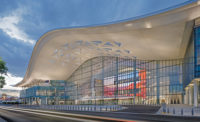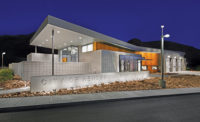Palace Station Casino, Resort Phase 1B
Las Vegas
Best Project
Owner/Developer: Station Casinos
Lead Design Firm: The Friedmutter Group
General Contractor: The PENTA Building Group
Structural Engineer: John A. Martin & Associates
Civil Engineer: Lochsa Engineering
MEP Engineer: NV5
Audio Visual: NTA
Food Service: Legacy Food Service Design
Subcontractors: Morse Electric; Montbleau & Assoc.; Avanti Glass and Mirror LLC; Capitol Builders Hardware LV; Kamran and Co.; Friedmutter Group; Curtainwall Design Consulting; EDS Electronics; Aries Consultants; JBA Consulting Engineers; T. Nickolas Co.; J&R Flooring; Stewart & Sundell Concrete; Arcon Global LLC; SunStone Building Specialists; Jemison Surveying & Services; Commercial Scaffolding of Nevada; Anning-Johnson; Las Vegas Demolition; Commercial Roofers; Absolute Metals; Boden Store Fixtures; Otis Elevator Co.; Bombard Electric; Desert Fire Protection; Hansen Mechanical Contractors; Redmond
The Palace Station Casino has an all new look after a nearly two-year complete renovation and expansion of the 41-year-old property. Phase 1B comprised the bulk of the work, including demolition of 25,000 sq ft of casino space and a two-story, 600-room motel. Replacing the demolished facilities are three restaurants, a buffet, a movie theater and a pool. All work occurred while the property and casino remained open to guests.
Despite the aggressive schedule and operational factors, PENTA Building Group completed the project with zero OSHA recordable incidents and no lost-time accidents during more than 400,000 work hours.
“Safety is obviously our No. 1 concern on a project. It is considered a cliché, but our most important concern is to make sure the public is safe. There is a certain inherent hazard when workers are on a job, but the public should never have to think twice. We call it building your bubble,” says Rodd Weber, corporate safety director at PENTA.
Elements of the safety strategy included having crews work off hours as well as holding daily safety huddles and weekly site-wide safety meetings to address operations and tasks happening that week. PENTA also implemented policies and procedures that surpassed industry requirements, including fall protection at any excavation with a vertical face greater than 6 ft deep and a 100% glove policy for all employees.
Bill Featherston, senior safety manager at PENTA, says the construction approach inside the casino centered around shielding the public through the use of extensive and intricate temporary walls as well as enclosed scaffolding. The temporary walls and ceilings included lighting, sprinklers and smoke detectors, Featherston says. The temporary walls “would stay in place for two to three months, then we would go to a different area and do it again.”
Synergy between the subcontractors and the casino back-of-house group promoted solutions for the movement of materials and supplies, Featherston says, adding that the nearby four-acre laydown area gave the team options to facilitate construction. The laydown yard had previously been used as a tractor-trailer parking lot.
“In some areas, we were able to prefab walls in the laydown yard. We brought them in on carts through the handicap ramps, put them up and added some crown molding,” he says.
In addition to typical construction hazards, PENTA worked to combat hazards associated with sun exposure through a partnership with Comprehensive Cancer Centers of Nevada. Featherston also brought in a member of the Nevada Dept. of Public Transportation to address domestic violence and what to do in an active-shooter incident.
Back to "ENR Southwest's 2019 Best Projects: Innovation, Skillful Renovations Lauded"








Post a comment to this article
Report Abusive Comment